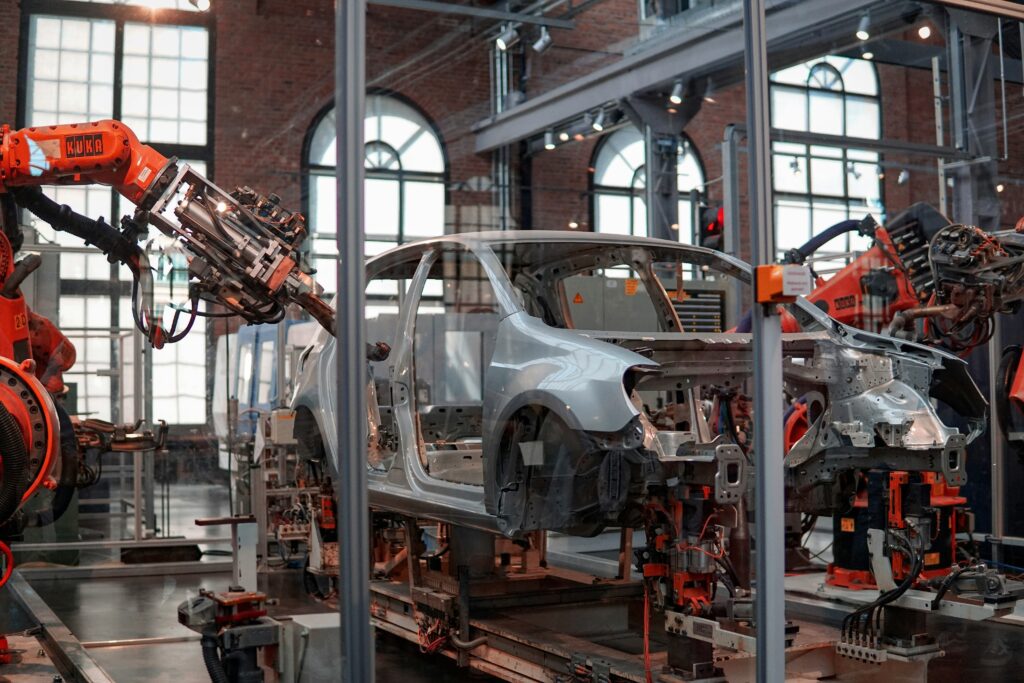Global Automotive market and shifts in the industry

The global automotive industry is one of the largest sectors of the world economy. In 2025, its size was estimated at around USD 4.6 trillion, covering passenger cars, commercial vehicles, parts, and services. Growth is steady rather than explosive, with projections pointing toward USD 6.68 trillion by 2032, a compound annual growth rate of just under 6%. Much of this growth is supported by demand in Asia, ongoing vehicle replacement in mature markets, and the increasing digitization of vehicles. While sales volumes are stabilizing, value expansion reflects higher average vehicle prices, rising integration of electronics, and premium services layered onto vehicles.
Electric vehicles (EVs) have become the most dynamic growth engine within the automotive industry. In 2024, the global EV market was valued at approximately USD 1.33 trillion, with projections for USD 1.6 trillion in 2025. Looking ahead, forecasts suggest the sector could expand to nearly USD 6.5 trillion by 2030, reflecting a remarkable compound annual growth rate of more than 30%. At that scale, EVs would account for almost half of the entire automotive market’s value by the end of the decade. China continues to dominate both as the largest buyer and leading manufacturer, while Europe and the United States are rapidly advancing on the back of stringent regulations, policy incentives, and accelerating investment in charging networks.
Traditional internal combustion engine (ICE) vehicles still make up most industry revenues today. They continue to generate trillions of dollars in sales annually, though their share is gradually declining as EV penetration rises. Hybrid vehicles soften the fall, especially in markets like Japan, the U.S., and parts of Europe, where they act as a transitional technology. Over the next decade, ICE vehicle revenues will likely plateau and decline slowly, while the EV segment captures most incremental value growth. That said, given the scale of the base, ICEs are expected to remain a multi-trillion dollar business well into the 2030s
Region wise market
Asia–Pacific
Asia–Pacific is the world’s largest automotive market, making up about 43% of global industry value in 2025. China alone sells over 30 million vehicles a year, and India is growing rapidly with more than 5 million annual sales. Japan is mature and shrinking slightly, while Southeast Asia is becoming a new hub with rising local manufacturing. The region’s automotive circular economy (recycling, remanufacturing) was worth USD 48 billion in 2025 and is projected to triple by 2034. Electrification and strong domestic production will keep Asia–Pacific dominant.
North America
North America holds about 26% of the global automotive market, with a projected value of ~USD 1.2 trillion in 2025. The U.S. drives most of the demand, focused on SUVs, pickup trucks, and crossovers. Electrification is picking up speed, though adoption rates lag China and Europe. Growth comes from vehicle replacement cycles, premium segments, and investment in connected-car technology. Overall expansion is steady, not explosive.
Europe
Europe accounts for around 21% of the market, worth nearly USD 969 billion in 2025. The region is shaped by strict EU emissions regulations and the planned 2035 ban on new combustion cars, which channel investment toward EVs and battery giga factories. Premium and luxury carmakers remain strong, while mid-market demand is pressured by competition from cheaper imports. Market growth is slower, with high volatility tied to subsidies and macroeconomic cycles.
Areas of focus for investment in the automotive industry
In 2025, investments in the automotive sector are predominantly flowing into electric vehicles, battery technology, mobility software, autonomous driving systems, and charging infrastructure, reflecting both regulatory pressure and shifting consumer preferences. The industry is rapidly advancing toward electrification and digitalization, with manufacturers channelling capital into EV production, next-generation batteries, and connected-vehicle platforms to meet stringent emissions standards and growing demand for sustainable mobility. Autonomous driving and smart vehicle software are also attracting major investments, as automakers seek differentiation through advanced safety features, in-vehicle personalization, and over-the-air service capabilities. With China, Europe, and the US leading in both innovation and factory buildout, the race is on for scalable, competitive solutions that will define automotive growth for years to come
China leads global automotive investments, especially in electric vehicles (EVs). In 2025, while domestic EV investments slowed, Chinese automakers like BYD, Nio, and Geely boosted overseas battery production and plant expansions to grow globally. BYD surpassed Tesla as the top EV maker by revenue, supported by strong government incentives and an integrated supply chain.
Europe is a top investment hub, spending over €70 billion annually on EVs, batteries, and software innovation. Germany, France, and the UK focus on decarbonization through EV plants, battery gigafactories, and green manufacturing, driven by strict regulations.
In North America, the US leads with major investments in EV production, battery supply, and digital vehicle tech, supported by government incentives to reshore supply chains. Canada and Mexico contribute via regional supply integration for both electric and traditional vehicles.
The automotive industry in 2025 faces slow growth but is rapidly transforming through electrification, digitalization, and shifting global dynamics. China leads in EV production and expansion, Europe excels in R&D and green manufacturing, and the US focuses on EV plants and supply chain resilience. Success will require innovation, agility, and adapting to new technologies and regulations in a highly competitive market.